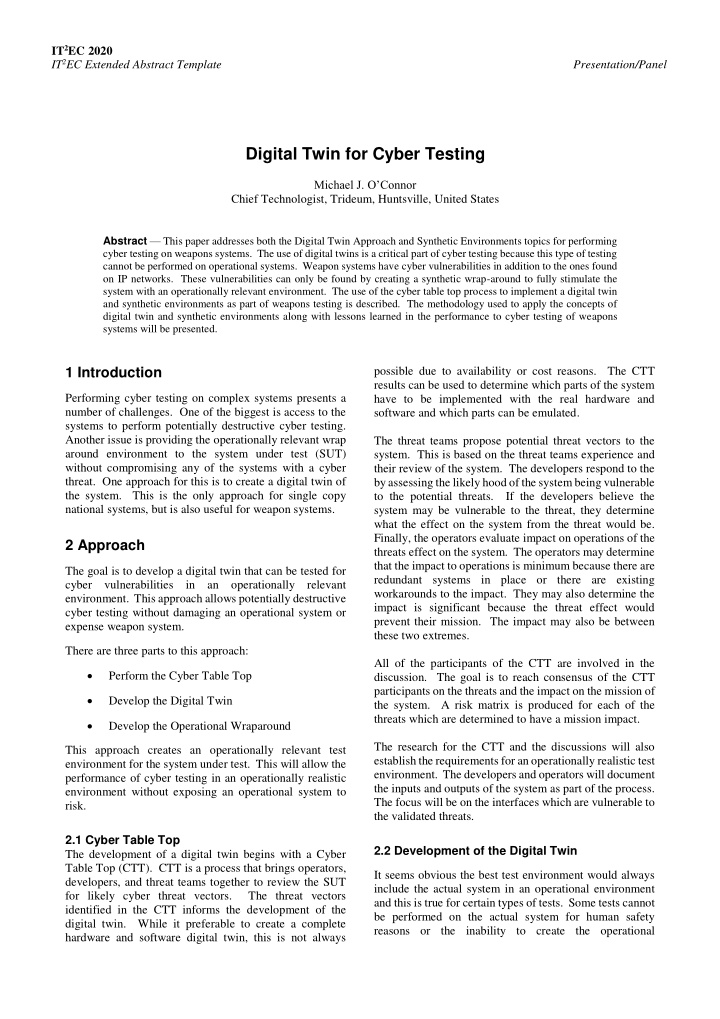



IT 2 EC 2020 IT 2 EC Extended Abstract Template Presentation/Panel Digital Twin for Cyber Testing Michael J. O’Connor Chief Technologist, Trideum, Huntsville, United States Abstract — This paper addresses both the Digital Twin Approach and Synthetic Environments topics for performing cyber testing on weapons systems. The use of digital twins is a critical part of cyber testing because this type of testing cannot be performed on operational systems. Weapon systems have cyber vulnerabilities in addition to the ones found on IP networks. These vulnerabilities can only be found by creating a synthetic wrap-around to fully stimulate the system with an operationally relevant environment. The use of the cyber table top process to implement a digital twin and synthetic environments as part of weapons testing is described. The methodology used to apply the concepts of digital twin and synthetic environments along with lessons learned in the performance to cyber testing of weapons systems will be presented. 1 Introduction possible due to availability or cost reasons. The CTT results can be used to determine which parts of the system Performing cyber testing on complex systems presents a have to be implemented with the real hardware and number of challenges. One of the biggest is access to the software and which parts can be emulated. systems to perform potentially destructive cyber testing. Another issue is providing the operationally relevant wrap The threat teams propose potential threat vectors to the around environment to the system under test (SUT) system. This is based on the threat teams experience and without compromising any of the systems with a cyber their review of the system. The developers respond to the threat. One approach for this is to create a digital twin of by assessing the likely hood of the system being vulnerable the system. This is the only approach for single copy to the potential threats. If the developers believe the national systems, but is also useful for weapon systems. system may be vulnerable to the threat, they determine what the effect on the system from the threat would be. Finally, the operators evaluate impact on operations of the 2 Approach threats effect on the system. The operators may determine that the impact to operations is minimum because there are The goal is to develop a digital twin that can be tested for redundant systems in place or there are existing cyber vulnerabilities in an operationally relevant workarounds to the impact. They may also determine the environment. This approach allows potentially destructive impact is significant because the threat effect would cyber testing without damaging an operational system or prevent their mission. The impact may also be between expense weapon system. these two extremes. There are three parts to this approach: All of the participants of the CTT are involved in the Perform the Cyber Table Top discussion. The goal is to reach consensus of the CTT participants on the threats and the impact on the mission of Develop the Digital Twin the system. A risk matrix is produced for each of the threats which are determined to have a mission impact. Develop the Operational Wraparound The research for the CTT and the discussions will also This approach creates an operationally relevant test establish the requirements for an operationally realistic test environment for the system under test. This will allow the environment. The developers and operators will document performance of cyber testing in an operationally realistic the inputs and outputs of the system as part of the process. environment without exposing an operational system to The focus will be on the interfaces which are vulnerable to risk. the validated threats. 2.1 Cyber Table Top 2.2 Development of the Digital Twin The development of a digital twin begins with a Cyber Table Top (CTT). CTT is a process that brings operators, It seems obvious the best test environment would always developers, and threat teams together to review the SUT include the actual system in an operational environment for likely cyber threat vectors. The threat vectors and this is true for certain types of tests. Some tests cannot identified in the CTT informs the development of the be performed on the actual system for human safety digital twin. While it preferable to create a complete reasons or the inability to create the operational hardware and software digital twin, this is not always
Recommend
More recommend